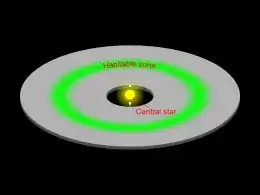As a general rule, gravity pulls you to the center of gravity of the most gravitationally influential object for your position. In this instance, it seems like it would be the ring. The center of gravity for the ring is... somewhere in that star. This means your people, unless they have things to brace themselves against, will fall into the star. Given that a habitable zone is usually on the order of ~1 AU for a star like ours, I'm willing to say that this will very likely be the case.
Vsauce did a video on a "flat earth" which has a simulation of a flat earth. It displays the problem with living on any disk-like object; the further from the middle you are, the more gravity pulls you to the center of that disk and less to the ground you're trying to walk on.
If the disk was spinning, it would not change the center-of-gravity for the disk. People would still fall into the middle unless they were at a very specific radius, where the acceleration provided by the disk/star's gravity forces them to essentially orbit the star. If you go too far to the edge or center, you'll fly off of fall in.
The best way to overcome this would require a disk that was much, much thicker than it is wide. Alternatively, your disk would need to be infinite in diameter to allow for equal gravity all along the disk. If you're willing to have a structure of nonuniform density, you could make the habitable zone much more dense (and therefore gravitationally stronger), but this still may not work because of that tricksy center-of-gravity.
What about this "infinite sheet approximation" people keep talking about, claiming that the gravity "close" to the surface would feel normal? Well, that's called the infinite sheet approximation, which is more often used in electromagnetism, but can be used in gravity. It turns out that this approximation is only good as long as the distance between you and the sheet is about 1/5 of the distance between the point below you (on the ring) to the edge of the sheet. So if your ring has a thickness of 1 au, your infinite sheet approximation works for 1/5 AU above the surface in the middle of the ring. If you're 1 m from the edge, the infinite plane approximation only holds to about 1/5 of a meter.
There is also the slight problem of that sun drifting into the side of your disk. Due to the fact that it is surrounded by an equal amount of material in the plane of the disk, it can drift around in that plane as if the disk wasn't there. (It's the 2-d case of gravitational force inside a shell.) This means your sun could very easily run into the inner radius, which I imagine would cause problems.
There are also some problems with tidal forces; the inner radius of your disk will experience more pull from the star than the outside of your disk. Unless the material is strong enough to withstand these forces, the star could rip the disk apart. Of course, the proposed disk is large enough that I think it must be made out of some magic material.
